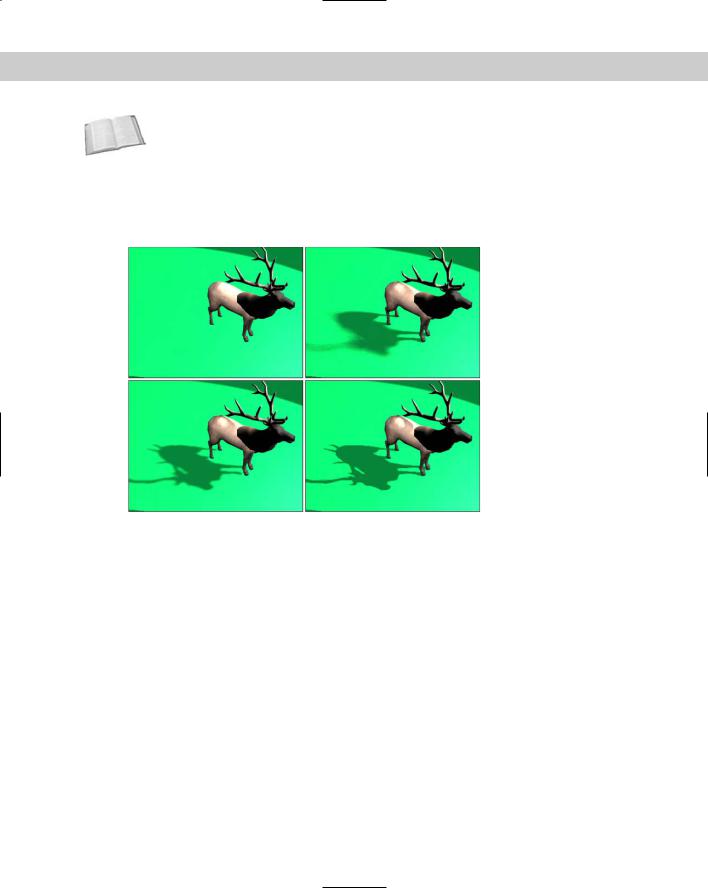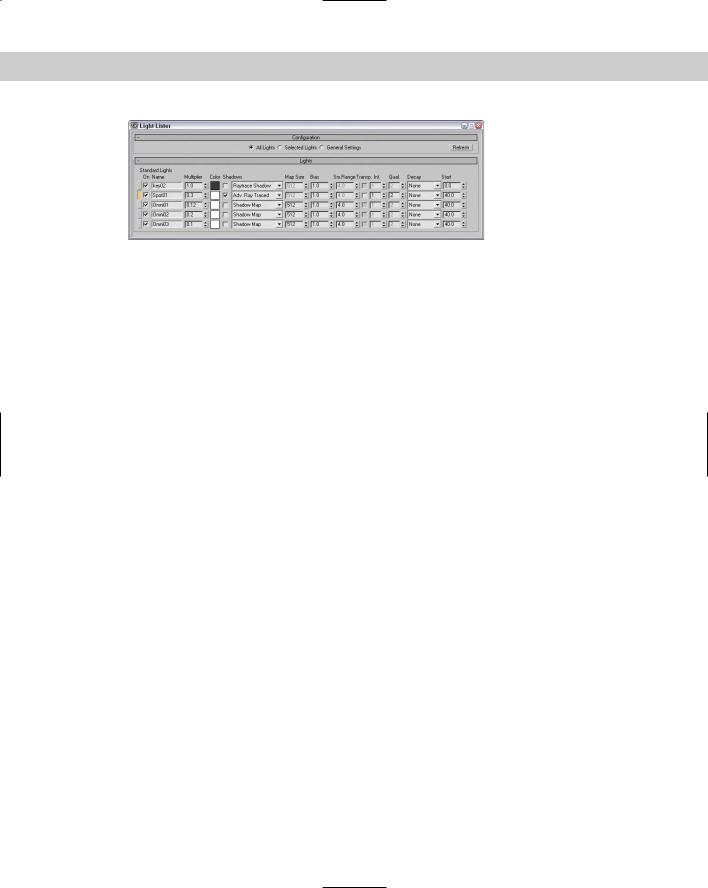
- •Preface
- •About This Book
- •Acknowledgments
- •Contents at a Glance
- •Contents
- •Relaxing at the Beach
- •Dressing the Scene
- •Animating Motion
- •Rendering the Final Animation
- •Summary
- •The Interface Elements
- •Using the Menus
- •Using the Toolbars
- •Using the Viewports
- •Using the Command Panel
- •Using the Lower Interface Bar Controls
- •Interacting with the Interface
- •Getting Help
- •Summary
- •Understanding 3D Space
- •Using the Viewport Navigation Controls
- •Configuring the Viewports
- •Working with Viewport Backgrounds
- •Summary
- •Working with Max Scene Files
- •Setting File Preferences
- •Importing and Exporting
- •Referencing External Objects
- •Using the File Utilities
- •Accessing File Information
- •Summary
- •Customizing Modify and Utility Panel Buttons
- •Working with Custom Interfaces
- •Configuring Paths
- •Selecting System Units
- •Setting Preferences
- •Summary
- •Creating Primitive Objects
- •Exploring the Primitive Object Types
- •Summary
- •Selecting Objects
- •Setting Object Properties
- •Hiding and Freezing Objects
- •Using Layers
- •Summary
- •Cloning Objects
- •Understanding Cloning Options
- •Mirroring Objects
- •Cloning over Time
- •Spacing Cloned Objects
- •Creating Arrays of Objects
- •Summary
- •Working with Groups
- •Building Assemblies
- •Building Links between Objects
- •Displaying Links and Hierarchies
- •Working with Linked Objects
- •Summary
- •Using the Schematic View Window
- •Working with Hierarchies
- •Setting Schematic View Preferences
- •Using List Views
- •Summary
- •Working with the Transformation Tools
- •Using Pivot Points
- •Using the Align Commands
- •Using Grids
- •Using Snap Options
- •Summary
- •Exploring the Modifier Stack
- •Exploring Modifier Types
- •Summary
- •Exploring the Modeling Types
- •Working with Subobjects
- •Modeling Helpers
- •Summary
- •Drawing in 2D
- •Editing Splines
- •Using Spline Modifiers
- •Summary
- •Creating Editable Mesh and Poly Objects
- •Editing Mesh Objects
- •Editing Poly Objects
- •Using Mesh Editing Modifiers
- •Summary
- •Introducing Patch Grids
- •Editing Patches
- •Using Modifiers on Patch Objects
- •Summary
- •Creating NURBS Curves and Surfaces
- •Editing NURBS
- •Working with NURBS
- •Summary
- •Morphing Objects
- •Creating Conform Objects
- •Creating a ShapeMerge Object
- •Creating a Terrain Object
- •Using the Mesher Object
- •Working with BlobMesh Objects
- •Creating a Scatter Object
- •Creating Connect Objects
- •Modeling with Boolean Objects
- •Creating a Loft Object
- •Summary
- •Understanding the Various Particle Systems
- •Creating a Particle System
- •Using the Spray and Snow Particle Systems
- •Using the Super Spray Particle System
- •Using the Blizzard Particle System
- •Using the PArray Particle System
- •Using the PCloud Particle System
- •Using Particle System Maps
- •Controlling Particles with Particle Flow
- •Summary
- •Understanding Material Properties
- •Working with the Material Editor
- •Using the Material/Map Browser
- •Using the Material/Map Navigator
- •Summary
- •Using the Standard Material
- •Using Shading Types
- •Accessing Other Parameters
- •Using External Tools
- •Summary
- •Using Compound Materials
- •Using Raytrace Materials
- •Using the Matte/Shadow Material
- •Using the DirectX 9 Shader
- •Applying Multiple Materials
- •Material Modifiers
- •Summary
- •Understanding Maps
- •Understanding Material Map Types
- •Using the Maps Rollout
- •Using the Map Path Utility
- •Using Map Instances
- •Summary
- •Mapping Modifiers
- •Using the Unwrap UVW modifier
- •Summary
- •Working with Cameras
- •Setting Camera Parameters
- •Summary
- •Using the Camera Tracker Utility
- •Summary
- •Using Multi-Pass Cameras
- •Creating Multi-Pass Camera Effects
- •Summary
- •Understanding the Basics of Lighting
- •Getting to Know the Light Types
- •Creating and Positioning Light Objects
- •Viewing a Scene from a Light
- •Altering Light Parameters
- •Working with Photometric Lights
- •Using the Sunlight and Daylight Systems
- •Using Volume Lights
- •Summary
- •Selecting Advanced Lighting
- •Using Local Advanced Lighting Settings
- •Tutorial: Excluding objects from light tracing
- •Summary
- •Understanding Radiosity
- •Using Local and Global Advanced Lighting Settings
- •Working with Advanced Lighting Materials
- •Using Lighting Analysis
- •Summary
- •Using the Time Controls
- •Working with Keys
- •Using the Track Bar
- •Viewing and Editing Key Values
- •Using the Motion Panel
- •Using Ghosting
- •Animating Objects
- •Working with Previews
- •Wiring Parameters
- •Animation Modifiers
- •Summary
- •Understanding Controller Types
- •Assigning Controllers
- •Setting Default Controllers
- •Examining the Various Controllers
- •Summary
- •Working with Expressions in Spinners
- •Understanding the Expression Controller Interface
- •Understanding Expression Elements
- •Using Expression Controllers
- •Summary
- •Learning the Track View Interface
- •Working with Keys
- •Editing Time
- •Editing Curves
- •Filtering Tracks
- •Working with Controllers
- •Synchronizing to a Sound Track
- •Summary
- •Understanding Your Character
- •Building Bodies
- •Summary
- •Building a Bones System
- •Using the Bone Tools
- •Using the Skin Modifier
- •Summary
- •Creating Characters
- •Working with Characters
- •Using Character Animation Techniques
- •Summary
- •Forward versus Inverse Kinematics
- •Creating an Inverse Kinematics System
- •Using the Various Inverse Kinematics Methods
- •Summary
- •Creating and Binding Space Warps
- •Understanding Space Warp Types
- •Combining Particle Systems with Space Warps
- •Summary
- •Understanding Dynamics
- •Using Dynamic Objects
- •Defining Dynamic Material Properties
- •Using Dynamic Space Warps
- •Using the Dynamics Utility
- •Using the Flex Modifier
- •Summary
- •Using reactor
- •Using reactor Collections
- •Creating reactor Objects
- •Calculating and Previewing a Simulation
- •Constraining Objects
- •reactor Troubleshooting
- •Summary
- •Understanding the Max Renderers
- •Previewing with ActiveShade
- •Render Parameters
- •Rendering Preferences
- •Creating VUE Files
- •Using the Rendered Frame Window
- •Using the RAM Player
- •Reviewing the Render Types
- •Using Command-Line Rendering
- •Creating Panoramic Images
- •Getting Printer Help
- •Creating an Environment
- •Summary
- •Creating Atmospheric Effects
- •Using the Fire Effect
- •Using the Fog Effect
- •Summary
- •Using Render Elements
- •Adding Render Effects
- •Creating Lens Effects
- •Using Other Render Effects
- •Summary
- •Using Raytrace Materials
- •Using a Raytrace Map
- •Enabling mental ray
- •Summary
- •Understanding Network Rendering
- •Network Requirements
- •Setting up a Network Rendering System
- •Starting the Network Rendering System
- •Configuring the Network Manager and Servers
- •Logging Errors
- •Using the Monitor
- •Setting up Batch Rendering
- •Summary
- •Compositing with Photoshop
- •Video Editing with Premiere
- •Video Compositing with After Effects
- •Introducing Combustion
- •Using Other Compositing Solutions
- •Summary
- •Completing Post-Production with the Video Post Interface
- •Working with Sequences
- •Adding and Editing Events
- •Working with Ranges
- •Working with Lens Effects Filters
- •Summary
- •What Is MAXScript?
- •MAXScript Tools
- •Setting MAXScript Preferences
- •Types of Scripts
- •Writing Your Own MAXScripts
- •Learning the Visual MAXScript Editor Interface
- •Laying Out a Rollout
- •Summary
- •Working with Plug-Ins
- •Locating Plug-Ins
- •Summary
- •Low-Res Modeling
- •Using Channels
- •Using Vertex Colors
- •Rendering to a Texture
- •Summary
- •Max and Architecture
- •Using AEC Objects
- •Using Architectural materials
- •Summary
- •Tutorial: Creating Icy Geometry with BlobMesh
- •Tutorial: Using Caustic Photons to Create a Disco Ball
- •Summary
- •mental ray Rendering System
- •Particle Flow
- •reactor 2.0
- •Schematic View
- •BlobMesh
- •Spline and Patch Features
- •Import and Export
- •Shell Modifier
- •Vertex Paint and Channel Info
- •Architectural Primitives and Materials
- •Minor Improvements
- •Choosing an Operating System
- •Hardware Requirements
- •Installing 3ds max 6
- •Authorizing the Software
- •Setting the Display Driver
- •Updating Max
- •Moving Max to Another Computer
- •Using Keyboard Shortcuts
- •Using the Hotkey Map
- •Main Interface Shortcuts
- •Dialog Box Shortcuts
- •Miscellaneous Shortcuts
- •System Requirements
- •Using the CDs with Windows
- •What’s on the CDs
- •Troubleshooting
- •Index

688 Part VI Lighting
Cross- You can learn more about raytracing and mental ray in Chapter 44, “Raytracing and mental
Reference ray.”
Figure 27-3 shows several images rendered with the different shadow types. The image in the upper-left includes no shadows. The upper-right image uses Area Shadows. The lower-left image uses a Shadow Map, and the lower-right image uses Advanced Raytraced Shadows. The last two images took considerably longer to create. Viewpoint Datalabs created the elk model shown in this figure.
Figure 27-3: Images rendered with different shadow types, including no shadow (upper left), Area Shadows (upper right), a Shadow Map (lower left), and Raytraced Shadows (lower right)
Getting to Know the Light Types
Max includes several different types of lights. The main difference in these types is how the light rays are cast into the scene. Light can come from the default lights that are present when no other user-created lights have been added to the scene. Light can also come from ambient light, which is light that bounces off other objects. Max also includes Omni, Direct, Spot, and skylights, each having its own characteristics. Understanding these sources of light will help you to know where to look to control the lighting.
Default lighting
So, you get Max installed, and you eagerly start the application, throw some objects in a scene, and render it — and you’ll be disappointed in the output, because you forgot to put lights in the scene. Right? Wrong! Max is smart enough to place default lighting in the scene that does not have any light.

Chapter 27 Basic Lighting Techniques 689
The default lighting disappears as soon as a light is created in a scene (even if the light is turned off). When all the lights in a scene are deleted, default lighting magically reappears. So you can always be sure that your objects are rendered using some sort of lighting. Default lighting actually consists of two lights: The first light is positioned above and to the left, and the bottom light is positioned below and to the right.
The Viewport Configuration dialog box has an option to enable default lighting for any viewport or set the default lighting to use only one light. You can open this dialog box by choosing Customize Configure or by right-clicking the viewport title and selecting Configuration from the pop-up menu.
If you want to access the default lights in your scene, you can use the Views Add Default Lights to Scene command to convert the default lights into actual light objects that you can control and reposition.
Ambient light
Ambient light is general lighting that uniformly illuminates the entire scene. It is caused by light that bounces off other objects. Using the Environment dialog box, you can set the ambient light color. You can also set the default ambient light color in the Rendering panel of the Preference Settings dialog box. This color is the darkest color that can appear in the scene, generally in the shadows.
In addition to these global ambient settings, each material can have an ambient color selected in the Material Editor.
Caution |
Don’t rely on ambient light to fill in unlit sections of your scene. If you use a heavy dose of |
|
ambient light instead of placing secondary lights, your scene objects appear flat, and you |
|
won’t get the needed contrast to make your objects stand out. |
Omni light
The Omni light is like a light bulb: It casts light rays in all directions. The two default lights are Omni lights.
Spotlight
Spotlights are directional: They can be pointed and sized. The two spotlights available in Max are a Target Spot and a Free Spot. A Target Spot light consists of a light object and a target marker at which the spotlight points. A Free Spot light has no target, which enables it to be rotated in any direction using the Select and Rotate transform button. Spotlights always are displayed in the viewport as a cone with the light positioned at the cone apex.
Cross- |
Both Target Spot and Target Direct lights are very similar in functionality to the Target Camera |
Reference |
object, which you learn about in Chapter 24, “Working with Cameras.” |
|
Direct light
Direct lights cast parallel light rays in a single direction, like the sun. Just like spotlights, direct lights come in two types: a Target Direct light and a Free Direct light. The position of

690 Part VI Lighting
the Target Direct light always points toward the target, which you can move within the scene using the Select and Move button. A Free Direct light can be rotated to determine where it points. Direct lights are always displayed in the viewport as cylinders.
Skylight
The Skylight is like a controllable ambient light. You can move it about the scene just like the other lights, and you can select to use the Scene Environment settings or select a Sky Color.
Creating and Positioning Light Objects
Max, in its default setup, can create many different types of light. Each has different properties and features. To create a light, just select Create Lights and choose the lights type or click the Lights category button in the Create panel. Then click the button for the type of light you want to create and drag in a viewport to create it. The six standard light types are Target Spot, Target Direct, Omni, Free Spot, Free Direct, and Skylight. Omni, Skylight, and Free lights are created with a single click, but you create Target lights by clicking at the light’s position and dragging to the position of the target. Spotlights are identified by a cone, and direct lights are identified by a cylinder shape.
Cross- |
The Create Lights Standard Lights menu includes the mr Area Omni and mr Area Spot |
Reference |
lights. These two lights are used with the mental ray renderer, which is discussed in Chapter |
|
|
|
44, “Raytracing and mental ray.” |
Transforming lights
Lights can be transformed just like other geometric objects; however, not all transformations are available for all the light types. An Omni light, for example, cannot be scaled, and rotating an Omni light has no effect on the scene. To transform a light, click one of the transformation buttons, and select and drag the light.
Target lights can have the light and the target transformed independently, or you can select both the light and target by clicking the line that connects them. Target lights can be rotated and scaled only if the light and target are selected together. Scaling a Target light increases its cone or cylinder. Scaling a Target Direct light with only the light selected increases the diameter of the light’s beam, but if the light and target are selected, then the diameter and distance are scaled.
An easy way to select or deselect the target is to right-click the light and select Select Target from the pop-up menu. All transformations work on free lights.
Listing lights
The Tools Light Lister menu command opens the Light Lister dialog box, shown in Figure 27-4, where you can see at a quick glance all the details for all the lights in the scene. This dialog box also lets you change the light settings. It includes two rollouts: Configuration, which lets you select to see All Lights, the Selected Lights, or the General Settings that apply to all lights; and Lights, which holds details on each individual light.

Chapter 27 Basic Lighting Techniques 691
Figure 27-4: The Light Lister dialog box includes a comprehensive list of light settings in one place.
If the General Settings option is selected, then a separate rollout opens with all the typical settings, including Multiplier, Color, Shadows, Map Size, and so on. You can apply these changes to the Selected Lights or to All Lights. The Light Lister provides an easy way to change the parameters of many lights at once.
If the All Lights or the Selected Lights options are selected, then the parameters are listed in the Lights rollout. Using this rollout, you can change the settings for any of the listed lights that affect all lights. The Refresh button updates the Light Lister dialog box if a new light has been added to the scene or if any parameters have been altered in the Modify panel.
Placing highlights
The Place Highlight (Ctrl+H) feature enables you to control the position and orientation of a light in order to achieve a highlight in a precise location. To use this feature, you must select a light object in the scene and then choose Tools Place Highlight, or click the Place Highlight flyout button on the toolbar. The cursor changes to the Place Highlight icon. Click a point on the object in the scene where you want the highlight to be positioned, and the selected light repositions itself to create a specular highlight at the exact location where you clicked. The light’s position is determined by the Angle of Incidence between the highlight point and the light.
Tutorial: Lighting the snowman’s face
You can use the Place Highlight feature to position a light for our snowman. To place a highlight, follow these steps:
1.Open the Snowman.max file from the Chap 27 directory on the CD-ROM. This file contains a simple snowman created using primitive objects.
2.Select the Create Lights Standard Lights Omni menu command, and position it below and to the left of the Snowman model.
3.To place the highlight so it shows the Snowman’s face, select the Omni light and then choose Tools Place Highlight (or press Ctrl+H). Then click the Snowman’s face where the highlight should be located, just above his right eye.
Figure 27-5 shows the results.
